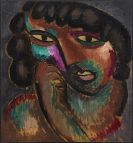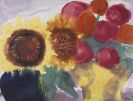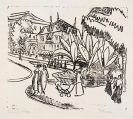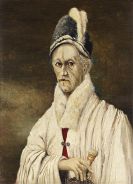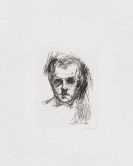
Heinrich Maria Davringhausen
Aachen
1894 -
Nizza
1970
Heinrich Maria Davringhausen spent his youth in Aachen and studied sculpture at the Düsseldorf Art Academy in 1913-14, where he met Carlo Mense. Rhenish Expressionism, with its leanings towards Fauvism, Cubism and Futurism, exerted a formative influence on Davringhausen's palette and composition.
In the years that followed, the artist travelled constantly and met Georg Schrimpf at the Monte Verità artists' colony near Ascona. Several portraits were done of him in a realistically overpainted manner which show the artist against a coloured Futurist background. The loss of an eye in his childhood ensured that the artist was spared military service when the first world war broke out. Heinrich Maria Davringhausen returned to Germany, moved to Munich in 1918 and joined the group of Düsseldorf artists known as "Das junge Rheinland".
Under the influence of the Cologne "progressives", Davringhausen now painted primarily abstract pictures with colour surfaces, some of them conceived in series. Between 1924 and 1925 the artist lived in Toledo, Spain, but chose to settle in Cologne in 1928, where he founded "Gruppe 32" with Anton Räder et al.
After he married Lore Auerbach, the daughter of a Jewish industrialist, the artist emigrated with his wife to Cala Ratjada on Mallorca in 1933. The outbreak of the Spanish Civil War in 1936 compelled Davringhausen to flee to Ascona via Marseilles and Paris. A year later his work was shown in the exhibition of "Degenerate Art".
In 1939 Heinrich Maria Davringhausen was expelled from Switzerland and moved with his family to Haut-de-Cagnes near Nice. After managing to escape from Les Milles, where he was interned in 1939-40, Davringhausen hid with his wife in Auvergne, returning to Haut-de-Cagnes after the war.
Most of Davringhausen's work was lost during the war due to his being outlawed by the National Socialists and being continually on the run. In the postwar years the artist exhibited his work, which reveals a close affinity with "Neue Sachlichkeit", at many galleries across the world. By the close of the 1950s art history was beginning to take notice of the New Objectivist style. As a result, Heinrich Maria Davringhausen's early work was shown at numerous exhibitions and was included in publications dealing with the "Neue Sachlichkeit" movement. The artist's comprehensive body of late work is primarily geometric and abstract yet it did not win much recognition.
Heinrich Maria Davringhausen died in Nice on 13 December 1970.
Would you like to sell a work by Heinrich Maria Davringhausen?
Infos for seller
